Are you claiming your adult products are "eco-friendly" but feel unsure how to back it up? This uncertainty can confuse customers and open your brand to accusations of greenwashing. Partnering with the right manufacturer helps you navigate certifications and prove your commitment to sustainability.
To ensure your TPE adult toy is genuinely eco-friendly, you must use a specific recyclable formulation, typically based on SEBS, and secure key environmental certifications. The most crucial ones are RoHS and REACH, which verify the material is free from hazardous substances. This provides concrete proof of safety and sustainability that goes beyond simple marketing claims, building trust with your customers.
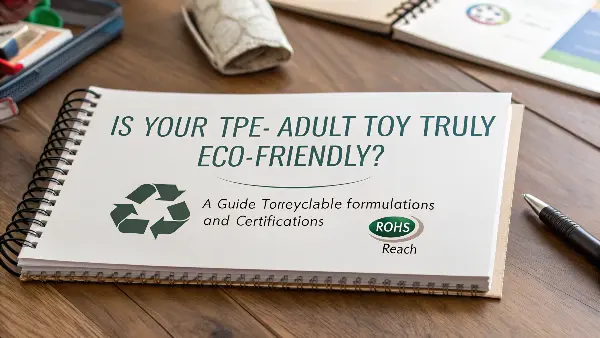
It’s one thing to say your product is green, but it’s another to prove it with credible, verifiable standards. Many brands I talk to get stuck here. They want to do the right thing, but the world of material science and international regulations feels overwhelming. It doesn’t have to be. We’re going to break down exactly what you need to know to move forward with confidence. Let’s demystify the process, from the chemistry of TPE to the paperwork of certification, so you can build a brand that is as responsible as it is pleasurable.
What Exactly Makes a TPE Formulation Recyclable?
You hear that TPE is recyclable, but what does that truly mean for your products? Not all TPEs are created equal, and choosing the wrong one can make your environmental claims invalid. This confusion can put both your brand integrity and your customers’ trust at risk.
A recyclable TPE formulation is a thermoplastic elastomer that can be melted and reshaped without losing its core structural integrity. The best formulations, like those using SEBS polymer, must be free from toxic additives, cheap fillers, or cross-linking agents that contaminate the recycling process. A transparent manufacturer will always provide documentation proving the purity and stability of their TPE.
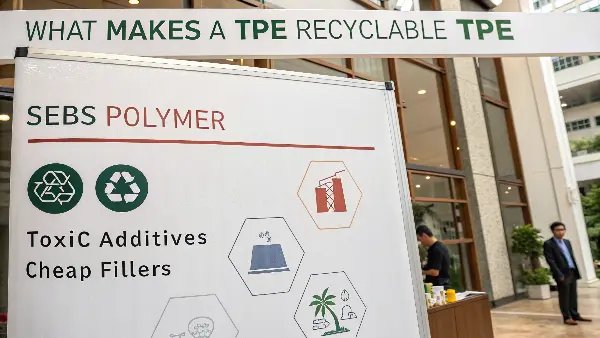
To really grasp this, it helps to understand a bit of the science behind the material. When we talk about plastics and elastomers, they generally fall into two categories: thermoplastics and thermosets. Thermoset materials, like silicone, undergo a chemical change when cured. You can’t melt them down and reuse them. Thermoplastics, however, can be melted and re-molded, much like wax. TPE—Thermoplastic Elastomer—belongs to this second group, which is why it has such great potential for recyclability.
The Chemistry of Recyclability
The most common base for high-quality, body-safe TPE is a Styrenic Block Copolymer (SBC). The two you’ll see most often are SBS and SEBS. While both are recyclable, SEBS (Styrene-Ethylene-Butylene-Styrene) is far superior for adult products. It’s more stable, has better resistance to UV and heat, and is hypoallergenic. The cheaper alternative, SBS, can break down over time and often has that strong "rubber" smell, which is a red flag.
The other key component is the plasticizing oil. This is what gives TPE its softness and flexibility. For a TPE to be body-safe and recyclable, it must use a medical-grade white oil. It has to be completely free of phthalates, which are harmful chemicals that have been linked to health issues and are restricted by regulations like REACH.
Common Additives That Hinder Recycling
The biggest threat to recyclability is contamination. Some manufacturers cut corners by using cheap fillers like calcium carbonate to lower costs. While a small amount might not hurt, a high percentage makes the material brittle and difficult to recycle properly. It turns a high-quality polymer into a low-grade composite. I remember a client who came to us after their supplier used a cheap TPE blend. The products started "sweating" oil after a few months—a clear sign of an unstable formulation that would be impossible to recycle and, frankly, unsafe for customers. A truly recyclable TPE is a pure, stable, and well-documented one.
| Feature | High-Quality Recyclable TPE | Low-Quality TPE |
|---|---|---|
| Base Polymer | SEBS (Stable, Hypoallergenic) | SBS (Less stable, strong odor) |
| Plasticizer Oil | Medical-Grade White Oil (Phthalate-Free) | Industrial-grade oils (May contain phthalates) |
| Fillers | None or minimal | High percentage (e.g., Calcium Carbonate) |
| Feel | Smooth, non-oily, durable | Oily "sweating," sticky, degrades quickly |
| Documentation | Full MDS/TDS provided | Vague or no documentation |
Which Environmental Certifications Actually Matter for TPE Adult Toys?
You’re ready to invest in sustainability, but the world of certifications is a confusing alphabet soup—RoHS, REACH, GRS, ISO. Which ones do your customers care about? Wasting time and money on irrelevant certifications won’t help your brand or your bottom line.
For TPE adult toys, the foundational certifications are RoHS and REACH. They confirm material safety by restricting hazardous substances, which is a prerequisite for any credible eco-friendly claim. While certifications like the Global Recycled Standard (GRS) are relevant for products made from recycled content, RoHS and REACH are the non-negotiable standards that prove your product is safe for both people and the planet.
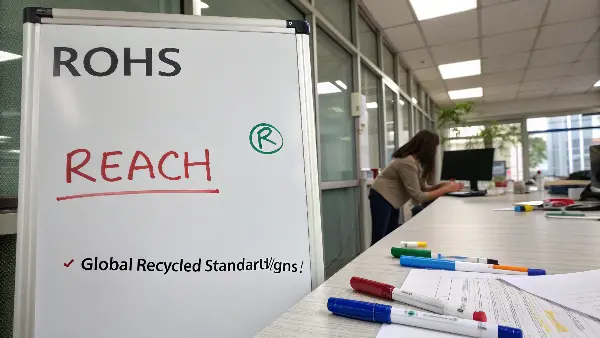
Navigating these standards seems daunting, but it’s simpler when you understand what each one is for. As a manufacturer, I’ve guided dozens of partners through this process. It all starts with knowing which certifications provide the most value and trust for your specific product category. For adult toys made from new (or "virgin") TPE, the focus is squarely on chemical safety.
Foundational Safety: RoHS and REACH
Think of these two as the bedrock of your product’s safety claims.
- RoHS (Restriction of Hazardous Substances): This directive originated in the EU to restrict specific hazardous materials found in electrical and electronic products. It limits substances like lead, mercury, cadmium, and certain phthalates. Even if your TPE toy isn’t electronic, complying with RoHS is a powerful statement. It tells customers that the base material is free from the most well-known toxins. It’s a globally recognized benchmark for safety.
- REACH (Registration, Evaluation, Authorisation and Restriction of Chemicals): This is another EU regulation, but it’s much broader than RoHS. It governs the production and use of chemical substances. For your brand, the most important part of REACH is its list of Substances of Very High Concern (SVHCs). Your TPE formulation must be free from these substances to be sold in the EU and to be considered truly body-safe. A REACH compliance certificate is one of the strongest proofs of safety you can have.
Proving Recyclability: The GRS Challenge
The Global Recycled Standard (GRS) is a fantastic certification, but its purpose is often misunderstood. GRS is designed to verify that a product contains recycled material. It tracks the recycled content from its source to the final product. Therefore, GRS is relevant if you are making toys from recycled TPE, not just claiming your virgin TPE is recyclable. Making this distinction is key to honest marketing.
Another one to know is ISO 14001. This isn’t a product certification; it certifies a company’s environmental management system. If your manufacturing partner is ISO 14001 certified, it shows they have systems in place to minimize their environmental impact, which adds another layer of credibility to your brand’s sustainable story.
| Certification | What It Verifies | Why It Matters for Your Brand |
|---|---|---|
| RoHS | Product is free from 10 specific hazardous substances. | Core safety standard, globally recognized. |
| REACH | Product is free from Substances of Very High Concern (SVHCs). | The gold standard for chemical safety in the EU. |
| GRS | Product contains a verified percentage of recycled material. | Use only if your product is made from recycled TPE. |
| ISO 14001 | Manufacturer has a certified environmental management system. | Shows your supplier is committed to sustainability. |
How Can You Verify a Supplier’s "Recyclable TPE" Claims?
Any supplier can say their TPE is "eco-friendly," but how can you be sure you’re not just being told what you want to hear? Trusting blindly is a huge risk that can lead to unsafe products, customs issues, and a shattered brand reputation. You need a clear, simple process for due diligence.
To verify a supplier’s claims, always request the Material Data Sheet (MDS) for the exact TPE formulation. This document details the polymer base and physical properties. Follow up by asking for existing RoHS and REACH compliance reports for that specific material. A trustworthy partner will provide these documents without hesitation. Finally, always get a physical sample to check for quality.
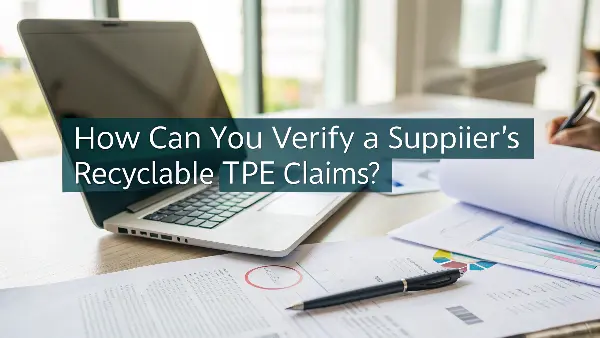
Over my years in manufacturing, I’ve seen firsthand how crucial this verification step is. The paper trail is just as important as the physical product. A few years ago, we were bidding on a project, and our quote was slightly higher. The client chose a cheaper supplier to save on costs. Six months later, they came back to us. Their first production run was stuck at EU customs because the supplier couldn’t provide any REACH documentation. It was a costly lesson for them: transparency on paper is non-negotiable.
The Power of the Material Data Sheet
The Material Data Sheet (MDS) or Technical Data Sheet (TDS) is your first piece of evidence. Don’t accept a generic sheet for "TPE." You need the specific one for the exact formulation that will be used in your product. Look for these key details:
- Polymer Base: It should clearly state SEBS or SBS. As we discussed, SEBS is what you want for a premium, body-safe product.
- Hardness (Shore): This tells you the softness of the material. Make sure it matches your product requirements.
- Physical Properties: Look for data on tensile strength and elongation at break. Higher numbers indicate a more durable, higher-quality material.
- Density: Unusually high density can indicate the use of cheap, heavy fillers.
Red Flags in Supplier Communication
Your interactions with a potential supplier are also revealing. Watch out for these red flags:
- Vagueness: If they answer questions about materials with generic terms like "eco-friendly plastic" or can’t specify the polymer type, be wary.
- No Documentation: A refusal or inability to provide an MDS, RoHS report, or REACH report is the biggest red flag. A reputable manufacturer has this documentation ready.
- Unusually Low Prices: If a price seems too good to be true, it probably is. It almost always points to the use of cheap, non-compliant fillers and oils.
- Hesitation to Provide Samples: You must test a physical sample. It shouldn’t feel oily, have a strong chemical smell, or be brittle.
Finally, consider investing in third-party testing with a lab like SGS or Intertek for your first major order. It’s a small price to pay for the ultimate peace of mind and the complete integrity of your brand.
How Do You Market Your Eco-Friendly TPE Products Effectively?
You did the hard work. You sourced a high-quality, recyclable TPE. You secured the right certifications. Now, how do you communicate all this value to your customers without boring them or, worse, being accused of greenwashing? Getting your marketing message wrong can make your entire investment invisible.
Market your eco-friendly products with transparency and specificity. Instead of vague terms like "green," use clear language like, "Made with 100% recyclable, body-safe SEBS and certified RoHS compliant." Feature certification logos on your product pages and packaging. Most importantly, educate customers on how to responsibly dispose of the product, showing your commitment extends beyond the sale and building deep trust.
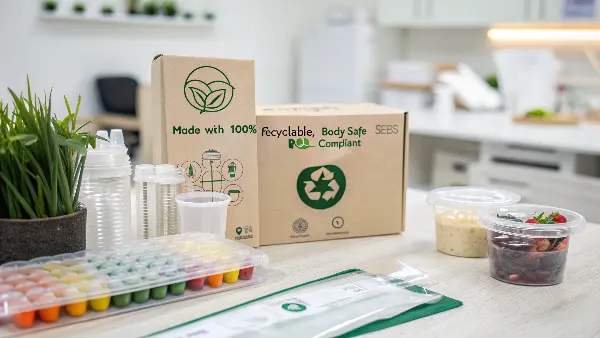
The brands I see succeeding are the ones that treat their customers like intelligent partners. They don’t just flash a green leaf logo; they explain why they chose a particular material and what it means for the customer’s health and the planet. This educational approach builds a loyal community around your brand. It shifts the conversation from just pleasure to responsible pleasure.
From Features to Benefits
Your customers don’t buy features; they buy benefits. Your job is to translate the technical details into tangible value. Avoid industry jargon and focus on what matters to them: safety, quality, and peace of mind.
| Vague Claim (Avoid) | Transparent, Benefit-Driven Claim (Use) |
|---|---|
| "Eco-Friendly Toy" | "Made with 100% recyclable TPE for a smaller environmental footprint." |
| "High-Quality Material" | "Our velvety-smooth TPE is Phthalate-Free and REACH certified for your peace of mind." |
| "Safe to Use" | "Body-safe and hypoallergenic. Certified RoHS compliant to be free from harmful toxins." |
Use clear icons on your product pages and packaging to communicate these benefits at a glance. Think "100% Recyclable," "Body-Safe," "Phthalate-Free," and "RoHS Compliant." These visual cues reinforce your message and make it easy for shoppers to understand your product’s value.
Building a Transparent Narrative
Go beyond the product page. Create a dedicated "Our Materials" or "Sustainability" page on your website. Here, you can tell the story behind your choices. Explain why you chose SEBS over other materials. Talk about what RoHS and REACH certifications mean in simple terms. This transparency is your greatest marketing asset.
A crucial part of this narrative is guiding customers on proper disposal. Most TPE products cannot go into standard curbside recycling bins. Be honest about this. Suggest specialized recycling programs (like TerraCycle) or, for a truly next-level commitment, consider implementing a take-back program where customers can send old products back to you for proper recycling. This closes the loop and demonstrates that your brand’s commitment to the environment is authentic and long-term.
Conclusion
Making a truly eco-friendly TPE adult toy requires more than just a marketing claim. It demands a commitment to using specific, recyclable formulations, securing vital safety certifications like RoHS and REACH, and communicating this transparently to your customers. This dedication to quality is what builds a trusted, lasting brand.
